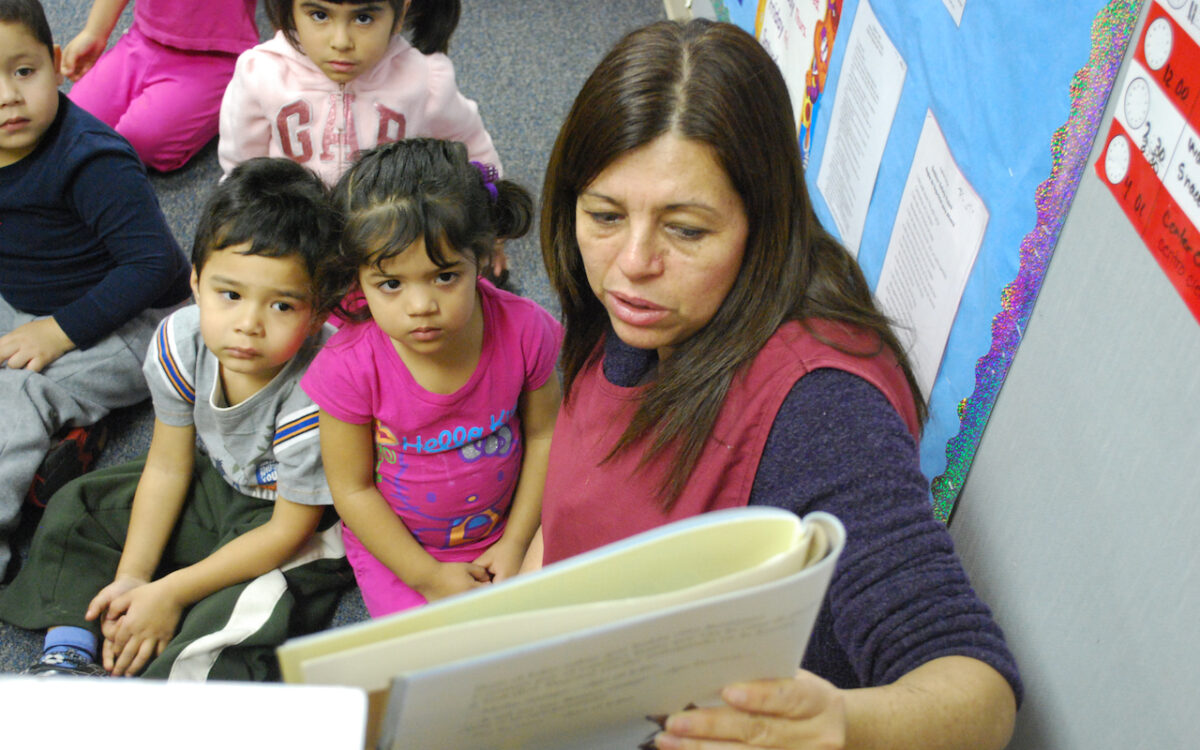Early ed: Fast-growing field, slow-growing pay
 Credit: Lillian Mongeau/EdSource Today
Credit: Lillian Mongeau/EdSource Today
A Head Start instructor reads to her students in a Central California classroom.
 Credit: Lillian Mongeau/EdSource Today
Credit: Lillian Mongeau/EdSource Today
A Caput Start instructor reads to her students in a Primal California classroom.
Those who care for and brainwash the nation's youngest learners piece of work in one of the fastest-growing industries in the state, according to new data from the Agency of Labor Statistics. That's the good news.
The bad news is summarized neatly on the dedication page of a recent report on the pay and working conditions of those who teach children 5 years old and younger: "This study is dedicated to the early on childhood teachers, of whom we expect so much, but to whom nosotros nonetheless provide and then trivial."
The Center for the Written report of Child Care Employment at UC Berkeley issued the report, titled, "Worthy Work, Even so Unlivable Wages." It was written by researchers Marcy Whitebook, Deborah Phillips, and Carollee Howes. The report examines the working weather condition of early childhood educators in the years following a 1989 study, "The National Child Care Staffing Study."
In the 25 years since that study was published, there has been growing awareness of the importance of providing quality early education programs, such as Head Start and other public and private daycares and preschools. Higher quality has resulted in the expectation that early childhood workers will attain a higher level of education. And workers have responded. According to the study, the number of Head Showtime teachers with an associate or bachelor's degree has increased by 61 percent over the last 17 years.
Withal, the report states, there is an "exceedingly low premium placed on bachelor'due south degrees inside the early care and educational activity field, relative to degreed teachers in 1000-12 education and in the civilian labor force every bit a whole." In both Head Start programs and community-based public pre-kindergarten settings, teachers with a bachelor's degree earn two-thirds of what public kindergarten teachers make.
In California, the average hourly wage of childcare workers, who are responsible for babies and toddlers, was $11.86 in 2013, barely budging from an hourly wage of $11.26 in 1997 when controlled for aggrandizement. For California'due south preschool teachers, tasked with preparing 3- to 5-year-olds for a strong starting time in schoolhouse, the news was just slightly better: their 2022 hourly wage was $16.46, compared with $14.02 in 1997.
Nationally, the Bureau of Labor Statistics puts early childhood educators in the bottom second or tertiary percentile of occupations by salary, slightly below dog walkers and in the aforementioned wage category as parking lot attendants.
What those wages hateful for early on childhood workers is that while they are caring for others' kids, their ain may not have enough to eat. A separate study conducted at UC Berkeley in 2022 revealed that 48 pct of childcare workers in one state were worried near having enough food for their families, and 73 percent were worried that they would not have enough money to pay their bills. In California, 48 percent of childcare workers' families were enrolled in at least one public assistance program, such as the Supplemental Diet Assistance Program (SNAP) or Medicaid.
To get more reports like this ane, click here to sign up for EdSource's no-cost daily email on latest developments in education.
Source: https://edsource.org/2014/early-ed-fast-growing-field-slow-growing-pay/71995
0 Response to "Early ed: Fast-growing field, slow-growing pay"
Post a Comment